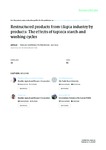Use este identificador para citar ou linkar para este item:
http://www.alice.cnptia.embrapa.br/alice/handle/doc/1018386Registro completo de metadados
| Campo DC | Valor | Idioma |
|---|---|---|
| dc.contributor.author | FOGACA, F. H. dos S. | pt_BR |
| dc.contributor.author | SANT'ANA, L. S. | pt_BR |
| dc.contributor.author | LARA, J. A. F. de | pt_BR |
| dc.contributor.author | MAI, A. C. G. | pt_BR |
| dc.contributor.author | CARNEIRO, D. J. | pt_BR |
| dc.date.accessioned | 2015-06-23T11:11:11Z | pt_BR |
| dc.date.available | 2015-06-23T11:11:11Z | pt_BR |
| dc.date.created | 2015-06-23 | pt_BR |
| dc.date.issued | 2015 | pt_BR |
| dc.identifier.citation | Food and Bioproducts Processing, Rugby, v. 94, p. 482-488, 2015. | pt_BR |
| dc.identifier.issn | 0960-3085 | pt_BR |
| dc.identifier.uri | http://www.alice.cnptia.embrapa.br/alice/handle/doc/1018386 | pt_BR |
| dc.description | The tilapia fileting industry generates large amounts of nutritionally significant waste material, and the recovery of this material is important. The manufacture of restructured products from mechanically recovered fish meat (MRFM) obtained from tilapia fileting allows the use of proteins of high biological value that would otherwise be discharged into the environment. The objective of this study was to evaluate the effect of washing cycles (either one cycle or five cycles) and of the addition of tapioca starch (20% vs. a no-starch control) on the characteristics of surimi obtained from MRFM produced by the tilapia industry and destined for use in restructured products. To evaluate the quality attributes of the product, the structure of a surimi protein matrix and its relationship to selected physicochemical parameters and morphological characteristics was assessed. Both the number of washing cycles and the starch addition were found to influence the moisture, protein and lipid content of the MRFM surimi. Higher whiteness was found after five washing cycles. Because the tapioca starch acted as a stabilizer, the fat globules were more stable and well distributed, and an emulsion with better properties resulted. A homogeneous network of fat globules linked to the protein matrix by a layer of tapioca starch was formed. Another advantage of this approach is that tapioca starch is gluten free. This property is important for specific groups in the population, e.g., celiac-intolerant consumers. | pt_BR |
| dc.language.iso | eng | eng |
| dc.rights | openAccess | eng |
| dc.subject | Carne de peixe industrializada | pt_BR |
| dc.subject | Microestrutura | pt_BR |
| dc.subject | Oxidação lipídica | pt_BR |
| dc.subject | Lipid oxidation | pt_BR |
| dc.subject | Mechanically recovered fish meat | pt_BR |
| dc.title | Restructured products from tilapia industry by products: the effects of tapioca starch and washing cycles. | pt_BR |
| dc.type | Artigo de periódico | pt_BR |
| dc.date.updated | 2018-03-28T11:11:11Z | pt_BR |
| dc.subject.thesagro | Tilápia | pt_BR |
| dc.subject.thesagro | Produção | pt_BR |
| dc.subject.thesagro | Cor | pt_BR |
| dc.subject.thesagro | Composição química | pt_BR |
| dc.subject.nalthesaurus | Microstructure | pt_BR |
| dc.subject.nalthesaurus | Chemical composition | pt_BR |
| dc.subject.nalthesaurus | surimi | pt_BR |
| dc.description.notes | Autoria na publicação: FABÍOLA HELENA FOGAÇA. | pt_BR |
| riaa.ainfo.id | 1018386 | pt_BR |
| riaa.ainfo.lastupdate | 2018-03-28 -03:00:00 | pt_BR |
| dc.identifier.doi | 10.1016/j.fbp.2014.07.003 | pt_BR |
| dc.contributor.institution | FABIOLA HELENA DOS SANTOS FOGACA, CPAMN; Léa Silvia Sant’Ana, CAUNESP; JORGE ANTONIO FERREIRA DE LARA, CPAP; Ana Cecilia Giacometti Mai; Dalton José Carneiro, CAUNESP. | pt_BR |
| Aparece nas coleções: | Artigo em periódico indexado (CPAMN)  | |
Arquivos associados a este item:
| Arquivo | Descrição | Tamanho | Formato | |
|---|---|---|---|---|
| ArtigoFabiolaFoodBioproducts2015.pdf | 1,49 MB | Adobe PDF |  Visualizar/Abrir |









